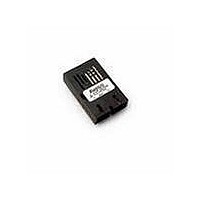AFBR-5805Z Avago Technologies US Inc., AFBR-5805Z Datasheet - Page 6

AFBR-5805Z
Manufacturer Part Number
AFBR-5805Z
Description
TXRX ATM SONET OC3 3V SC 1X9
Manufacturer
Avago Technologies US Inc.
Series
-r
Specifications of AFBR-5805Z
Wavelength
1310nm
Applications
General Purpose
Voltage - Supply
3.3V
Connector Type
SC
Mounting Type
Through Hole
Function
Provides the system designer with products to implement a range of soluntions for multimode fiber SONET OC-3 (SDH STM-1)
Product
Transceiver
Data Rate
155 Mbps
Maximum Rise Time
3 ns/2.2 ns
Maximum Fall Time
3 ns/2.2 ns
Pulse Width Distortion
1.2 ns (Max)/1.91 ns (Max)
Maximum Output Current
50 mA
Operating Supply Voltage
3.135 V to 3.5 V or 4.75 V to 5.25 V
Maximum Operating Temperature
+ 70 C
Minimum Operating Temperature
0 C
Package / Case
SIP-9
Lead Free Status / RoHS Status
Lead free / RoHS Compliant
For Use With
Multimode Glass
Lead Free Status / RoHS Status
Lead free / RoHS Compliant, Lead free / RoHS Compliant
Available stocks
Company
Part Number
Manufacturer
Quantity
Price
Company:
Part Number:
AFBR-5805Z
Manufacturer:
Avago Technologies
Quantity:
135
Transceiver Signaling Operating Rate Range and BER
Performance
For purposes of defi nition, the symbol (Baud) rate, also
called signaling rate, is the reciprocal of the symbol time.
Data rate (bits/sec) is the sym bol rate divided by the en-
coding factor used to encode the data (symbols/bit).
When used in 155 Mb/s SONET OC-3 applications the
perform ance of the 1300 nm transceivers, AFBR-5805 is
guaranteed to the full conditions listed in product speci-
fi cation tables.
The transceivers may be used for other applications at
signal ing rates diff erent than 155 Mb/s with some varia-
tion in the link optical power budget. Figure 5 gives an
indication of the typical performance of these products at
diff erent rates.
These transceivers can also be used for applications
which require diff erent Bit Error Rate (BER) performance.
Figure 6 illustrates the typical trade-off between link BER
and the receivers input optical power level.
Figure 5. Transceiver Relative Optical Power Budget
at Constant BER vs. Signaling Rate.
6
2.5
2.0
1.5
1.0
0.5
0.5
0
0
CONDITIONS:
1. PRBS 2
2. DATA SAMPLED AT CENTER OF DATA SYMBOL.
3. BER = 10
4. T
5. V
6. INPUT OPTICAL RISE/FALL TIMES = 1.0/2.1 ns.
A
CC
25
= +25° C
= 3.3 V to 5 V dc
7
-1
-6
50
SIGNAL RATE (MBd)
75
100
125
150
175
200
Transceiver Jitter Performance
The Avago Technologies 1300 nm transceivers are de-
signed to operate per the system jitter allocations stated
in Table B1 of Annex B of the draft ANSI T1E1.2 Revision 3
standard.
The Avago Technologies 1300 nm transmitters will toler-
ate the worst case input electrical jitter allowed in Annex
B without violating the worst case output jitter require-
ments.
The Avago Technologies 1300 nm receivers will toler-
ate the worst case input optical jitter allowed in Annex
B without violating the worst case output electrical jitter
allowed.
The jitter specifi cations stated in the following 1300 nm
transceiver specifi cation tables are derived from the
values in Tables B1 of Annex B. They represent the worst
case jitter contribution that the trans ceivers are allowed
to make to the overall system jitter without violating the
Annex B allocation example. In practice the typical con-
tribution of the Avago Technologies trans ceivers is well
below these maximum allowed amounts.
Figure 6. Bit Error Rate vs. Relative Receiver Input
Optical Power.
1 x 10 -10
1 x 10 -11
1 x 10 -12
1 x 10 -2
1 x 10 -3
1 x 10 -4
1 x 10 -5
1 x 10 -6
1 x 10 -7
1 x 10 -8
1 x 10 -9
-6
CONDITIONS:
1. 155 MBd
2. PRBS 2
3. CENTER OF SYMBOL SAMPLING
4. T
5. V
6. INPUT OPTICAL RISE/FALL TIMES = 1.0/2.1 ns.
RELATIVE INPUT OPTICAL POWER - dB
A
CC
= +25°C
= 3.3 V to 5 V dc
-4
7
-1
-2
AFBR-5805Z SERIES
CENTER OF SYMBOL
0
2
4

























